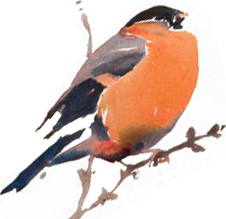This year, I published a monograph, The Purple Sandpiper, based partly on studies and surveys carried out jointly by the Tay, Grampian, Highland and Orkney Ringing Groups. This collaboration over 50 years was extremely effective because it allowed the strengths of different individuals to contribute in a variety of ways to the themes of the study as it progressed. At the start of the study in the early 1970s, little was known about the numbers, distribution, population structure and origins of Purple Sandpipers in the UK. There had been only one overseas ringing recovery, in Greenland, of a bird ringed in Cheshire, but Greenland later proved not be a breeding destination. (The image on the right shows a Purple Sandpiper foraging at the water's edge of a rocky shore. The diet is mainly periwinkles and Blue Mussels.)
As the studies progressed, interesting facts were established. In the 1970s/80s, the UK population of Purple Sandpipers was estimated as c. 19,000. The largest number occurred in Orkney (5700), and the Outer Hebrides, Shetland and northern part of the Scottish mainland also supported large numbers. About a quarter of the winter population originated from Norway, but the bulk came from northern Canada. A small number also came from Svalbard. The Norwegian birds moult on their arrival in the UK, but the Canadian birds moult in Arctic Canada before migrating across the North Atlantic to Scotland and Ireland. The latter journey is accomplished in a single flight in November, so Canadian birds arrive later than the Norwegian birds. On their spring migration though, Iceland and Greenland are used as staging sites. The number of wintering birds has declined, so the Purple Sandpiper is now Amber-listed in the UK’s Birds of Conservation Concern 5 (available here). There is some evidence that years of poor breeding have led to the decline in number, but the reason for poor breeding is unknown.

A Purple Sandpiper brooding newly-hatched chicks in the nest
All studies lead to further questions[1]. Although we established that most of our wintering Purple Sandpipers come from Arctic Canada, with some breeding on Baffin Island, we don’t know where the majority breed. This is because we used geolocators to determine the route to Canada. Geolocators rely on the transitions between dark and light (twilights) to make estimates of location and this is not possible in continuous daylight and, consequently, they failed to give mid-summer geolocations when the birds breed. As the more sophisticated tags become smaller, we will be able answer which other parts of the Canadian Arctic are used for breeding.

Contrasting bill sizes of female (left) and male (right) Purple Sandpipers
Our studies found that most Purple Sandpiper populations in winter have more males than females. This uneven sex ratio applies to first-year birds as well as adults, so the greater mortality amongst females must occur at the juvenile stage. The sex ratio at hatching is even, as in most birds. The reason why juvenile females die faster than males may be because the female chicks are relatively lighter than male chicks and thereby fledge in a poorer condition than males. It would be interesting to see if the same applies to other sandpipers.

A Purple Sandpiper chick
As well as a difference in size between the sexes (females are bigger than males), there is also a difference in size between different breeding populations. A Norwegian male Purple Sandpiper is about the size of a Dunlin, whilst a female Purple Sandpiper from Iceland is as big as a Turnstone. Why should this be? Key to this aspect of Purple Sandpiper biology is explaining why Icelandic Purple Sandpipers are so big.
From these few suggestions as avenues for further work, I hope that work on Purple Sandpipers will continue. We also need folk that are able to continue to do low-tide rocky-shore wader surveys in winter – not an easy task.

A flock of Purple Sandpipers landing on the pier at Balintore Harbour, Ross-shire. Most belong to the north Candian breeding population
The Purple Sandpiper (available through NHBS) was produced with generous support from the SOC, through its publication grant scheme, the Birds of Scotland Fund. Details of other publications that have secured funding from the SOC can be found here.
Ron Summers
[1] For a comprehensive summary of the knowledge gaps of birds in Scotland, please see "What we don't know about birds in Scotland" in Scottish Birds 43: 118-131 (Summers, Lewis, Hunter 2023), and refer to the accompanying database here. Although much is known about the biology of the birds that live in Scotland, it is useful to have up-to-date information on the status of populations, ideally followed up with an understanding of the reasons for any change. Armed with such knowledge, conservation measures may be implemented.




